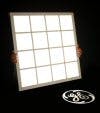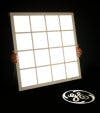The key advantages of OLEDs are high efficiency, the ability to construct the devices on thin and flexible substrates, and low potential cost - GE is currently involved in another project to develop a roll-to-roll production machine for OLED manufacturing.
However, together with cost, the big drawback for OLEDs is lifetime: the 1200 lumen panel had a life of about 400 hours, which is significantly less than equivalent white LEDs can manage.
****
This is an extract from a longer article originally published in the October 2004 issue of Compound Semiconductor magazine.







